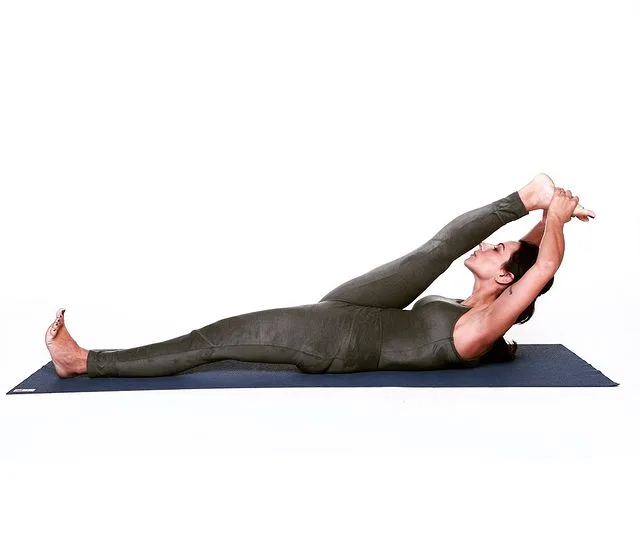Supta Padangusthasana, also known as Reclining Big Toe Pose, or Sleeping Big Toe Pose, stretches the hamstrings, gastrocnemius and gluteus maximus of the leg held in the air.
In this pose, the weight of your torso draws your leg deeper into the stretch, while at the same time your quadriceps are engaged to straighten your knee and create a reciprocal inhibition of your hamstrings.
Experts believe that regular practice of Supta Padangusthasana legs will lead to proper development. Individuals suffering from sciatica and paralysis of legs will get a lot of benefit from this pose. Blood is made to circulate to the legs and hips, where the veins are rejuvenated. This asana removes stiffness in the hip joints and prevents hernia. This yoga pose can be practiced by both men and women.
Information
| Known as: | Supta Padangusthasana, Reclining Big Toe Pose, Sleeping Big Toe Pose, Supta Padangusthasana A, Reclining Big Toe Pose A |
| Sanskrit name: | सुप्त पादाङ्गुष्ठासन |
| IAST: | Supta pādāṅguṣṭhāsana |
| Pronunciation: | soup-TAH pod-ang-goosh-TAHS-anna |
| Level: | Intermediate |
| Type: | Reclining, relaxation, restorative, supine |
| Total time: | 30 seconds to 2 minutes |
| Drishti: | At ceiling; At big toe |
| Chakra: | Swadisthana Chakra, Muladhara Chakra |
| Focus: | Legs |
| Indications: | Prostate gland, menstrual, back discomfort, hip joints and prevents hernia, sciatica and paralysis |
| Counterpose: | Apanasana (Knees-to-Chest Pose) |
| Preparatory poses: | Uttanasana, Baddha Konasana, Adho Mukha Svanasana, Ardha Pavanamuktasana |
| Follow-up poses: | Standing Poses, Seated Forward Bends |
| Contraindications: | High blood pressure, Diarrhea, Headache, |
Meaning
The Supta Padangusthasana is derived from the Sanskrit name, which is made up of four words — Supta + Pada + Angustha + Asana:
- “Supta” = “recline or lying down”
- “Pada” = “foot”
- “Angustha” = “big toe”
- “Asana” = “pose or posture”
As the Supta Padangusthasana is performed, hold onto the big toe with the hand and lie on the floor, hence its name. It is translated into English as Reclining Big Toe Pose.
If you run, bike, swim, play sports, lift weights, or spend a lot of time sitting, you may be familiar with tight hamstrings! These posterior thigh muscles can become stiff from both over-use and under-use, but practicing this yoga asana regularly helps to increase the flexibility of these muscles.
Benefits of Supta Padangusthasana (Reclining Big Toe Pose)
Since Supta Padangusthasana (Reclining Big Toe Pose) is an asymmetrical stretch performed on one leg at a time, your both legs still benefit. This is because the pose requires the practitioner to be careful to keep the resting leg extended and firm. Thus, this practice is the act of raising the level of your consciousness and bringing awareness to your body.
Supta Padangusthasana (Reclining Big Toe Pose) stimulates the Muladhara Chakra. Muladhara helps you stay connected. The is also associated with abundance, passion and family. It is believed to activate your Swadhisthana Chakra, which is the creative energy center and is associated with sexual energy. A balanced Swadhisthana protects you from fear of change while promoting emotional stability, joy, abundance and bliss.
However, the physical and mental benefits of this yoga pose are listed below:
- Physical Benefits:
- Stretches hips, calves, and thighs
- Strengthens the knees
- Strengthen arches of the feet
- Opens the hamstrings and psoas muscles
- Stimulates prostate gland
- Relieves sciatica and low back discomfort
- Relieves menstrual and back discomfort
- Promotes reproductive health
- Improves digestion
- Mental Benefits:
- Relieves stress
- Calms the mind
Supta Padangusthasana (Reclining Big Toe Pose) Practice Guide
This is an excellent yoga pose in which to apply a smooth stretch. Do this by grasping the foot firmly by the heel, and then try to bend the knee, eccentrically contracting the hamstrings. It stimulates the Golgi tendon organ, a sensory receptor located at the muscle-tendon junction. The Golgi tendon organ then signals to the spinal cord that tension has increased, and the spinal cord completes the feedback loop by signalling the hamstrings to relax into the stretch. It is part of a complex system that controls muscle tension and length. Use this technique with caution.
Although the main story of Supta Padangusthasana (Reclining Big Toe Pose) is the stretching of the back of your holding leg, there is a subplot in your leg that rests on the mat. Focus on the challenge of keeping your hip extended, your thigh inward rotation, and your heel on the floor. Yet it is the form of posture you need to work on. Use the muscles of your buttocks and lower back to pull your heel down, and to bring your kneecap straight up by using the internal rotators of your hip. It’s step-by-step explained in the anatomy engaging techniques section.
Technique-1
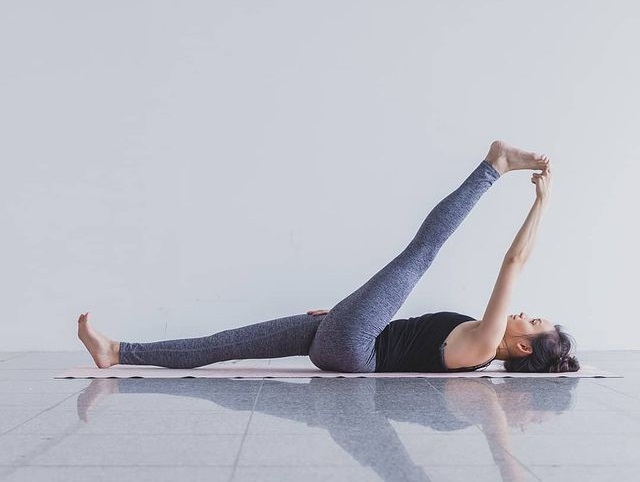
Instructions:
- Lie flat on the floor; Engage the legs and spread the toes. Keep the upper thighs on the floor as firmly as possible. Arch the lower back slightly to help lower the thighs.
- Bend the left knee and grasp the big toe on the inside of the thigh. Grasp your big toe with your first two fingers and thumb, wrapping your fingers on the inside of the toe. Keep the right thigh pressed to the floor.
- While grasping the big toe, lift the left leg up, resting the right thigh on the floor. Extend from the pelvis to the bottom of the left foot, and press your left thigh away from your abdomen into your hamstrings. Use your right hand to help press the right thigh down. Press the shoulders into the floor and slide the shoulder blades down your back toward the waist.
- Breathe smoothly and immerse yourself in the feeling of stretching. Stay in this position for 30 seconds to 2 minutes. Then come out from the posture gently and repeat the process the other side.
Beginners’ Guide to Supta Padangusthasana
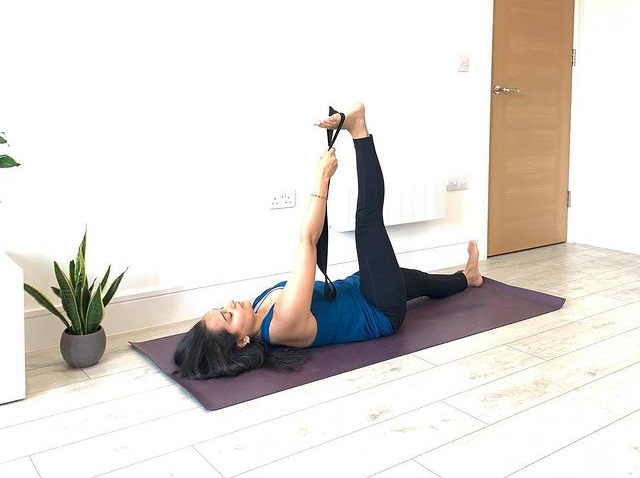
Instructions:
Follow the instructions in Steps 1 through 3, but use a strap on the sole of your foot. Hold the end of the strap with one hand.
Technique-2
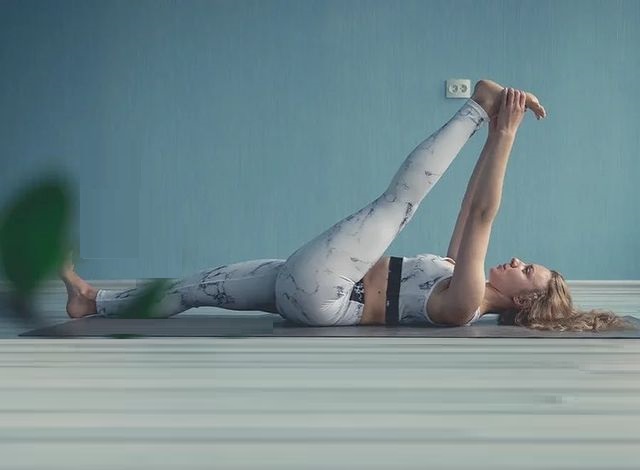
Instructions:
- Lie flat on the floor; Engage the legs and spread the toes. Keep the upper thighs on the floor as firmly as possible. Arch the lower back slightly to help lower the thighs.
- Straighten the right leg above your head and grasp your foot with both hands. Put your left thumb between your big toe and second toe, and your right thumb between your little toe and ring toe. It gives you a good grip and helps to stretch your toes.
- Tip: If you can’t reach your foot, use a belt or strap to span the gap, or clasp the ankle, calf, or thigh.
- Press your right leg completely straight, tighten your quadriceps and raise the heel toward the ceiling. Then spread the toes and press the ball of your big toe away from you so that your leg line spirals slightly inward and is directed outward in the direction your leg is pointing. As you do this, press your sacrum firmly into the floor and gently pull your leg toward you, flattening your shoulder blades and rounding your chest. Breathe smoothly, wait for the stretch sensations to subside before proceeding. Stay here for several breaths.
- Keep your left leg straight on the floor. Extend your toes and push outward through the ball of your foot. Keeping your sacrum pressed firmly, continue to drive your shoulders toward the floor so that your shoulder blades are flattened, and press both feet away from you as you gently pull your leg tight. Breathe smoothly and immerse yourself in the feeling of stretching. Stay here for 30 seconds to 2 minutes. Then come out from the posture gently and repeat the process the other side.
Beginners’ Guide to Supta Padangusthasana
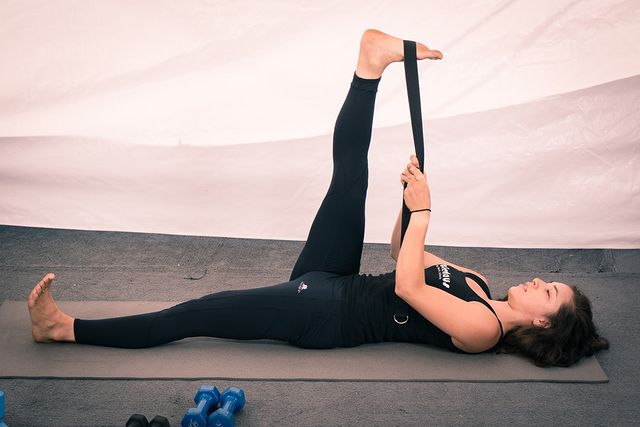
Instructions:
- Use a belt or strap to hold your foot in place. Bend your elbows to bring your leg closer. Do not rush or force the stretch, as this can cause or damage your hamstrings. When you are flexible enough, you can reach up and take your foot or lower leg with your hands.
- While holding your foot, try to use your shoulder muscles to lift your arms up towards your head and draw your leg deeper into the stretch. During this, you can keep your other knee bent.
- For the final pose, straighten your knee and internally rotate the thigh of your leg, that is on the floor.
Step-by-step Anatomy Engaging Techniques
Step-1
- Activate your hip flexors, including your psoas, pectineus and adductors longus and brevis, to bring your leg up. Note that when your hip is fully bent, these muscles can generate very little force because they are beyond their optimal contractile length.
- Squeeze your abs to flex your trunk toward your leg, and contract your quadriceps to straighten your knee. This initiates a reciprocal inhibition of your muscles that are lengthening and allows them to relax in the stretch.
Step-2
- Grasp your feet with your hands and try to raise the arms above your head. This engages your anterior deltoids and draws your leg deeper into the stretch.
- Externally rotate your shoulders by activating your infraspinatus and teres minor muscles of your rotator cuff.
- Flex your elbows to engage your biceps and brachialis muscles to pull your leg deeper into the stretch.
- Holding your foot, raise the forearms while trying to turn your palms upwards. This adds a “helical” force through your elbows from the feet to the shoulders, creating a wrinkling effect that stabilizes your foot and draws your leg deeper into the pose.
Step-3
- Contract your erector spinae and quadratus lumborum to extend your lower back.
- Tilts your pelvis forward by stretching your lower back. This moves the origin of your hamstrings back and away from their insertion, stretching your muscles.
- Engage the lower third of your trapezius to draw your shoulders down and away from your neck. Notice how this action brings your foot closer to your face.
- Activate your rhomboids to draw your shoulder blades toward the midline, expanding the front of the chest.
Step-4
- Your lower leg rises off the floor and rotates outwards in this pose. Address the lift by contracting your buttocks to extend your hips, and engage your quadriceps to straighten your knee. Activating your gluteus maximus also externally rotates your thigh.
- Ideally, your foot is in a neutral position, with your kneecap pointed upward. This requires internal rotation of your leg. Create this action by pressing your heel into the floor and trying to drag your foot out to the side. Although your heel will not move, it contracts your gluteus medius and tensor fascia lata. As a result, your thigh turns inward toward neutral. Your tensor fascia lata also crosses your knee, stabilizing it in extension.
- Elevate your foot by activating your peroneus longus and brevis on the side of your leg. Watch the direction of these muscles to see how they open the sole of your foot and turn it outward. Balance this action by engaging your tibialis posterior, which reverses your foot. Co-activation of these muscles stabilizes your ankle.
Precautions and contraindications
Some precautions and contraindications have been explained below to keep in mind while practicing Supta Padangusthasana:
Injury to hamstrings or quadriceps
Hamstring and quadriceps should be avoided primarily from athletes, because these muscles will be deeply expanding during practicing of this yoga pose.
Weak legs and hips
In this yoga pose, the strength of the legs and hips is tested, and therefore if one’s legs and hips are weak, then this yoga pose should be practiced under the guidance or support of an expert yoga teacher/instructor. It is also better to go slow with Supta Padangusthasana (Reclining Big Toe Pose).
Shoulder injury
Although this yoga asana is still supine, and brings less pressure on the whole back, yet the shoulders are spread to hold the big toe with the hand, and therefore any kind of restlessness or pain around the shoulders will make it worse with this deep stretch yoga pose.


